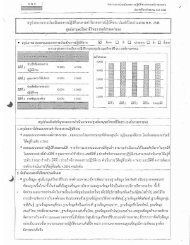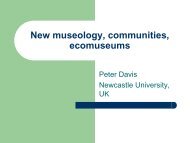Download
Download
Download
You also want an ePaper? Increase the reach of your titles
YUMPU automatically turns print PDFs into web optimized ePapers that Google loves.
elongs to certain groups. When claims are made, there isnot a process in place for responding to them. We need tocome up with a multifaceted method - one that does not onlyemphasize community rights, or mainstream museologicalprinciples, for example - but is nuanced and case-specific.”SAC staff wrestled with the ideas of Brown asthey divided into small groups to brainstorm examples ofcultural rights-claiming behaviors in Thailand. Discussionsof the Assembly of thePoor protest of 1997,Yong language andidentity revitalizationin Lamphun, and theMinistry of CulturedesignatedKarenSpecial Cultural Zoneled to exchange about ownership and the managementof the SAC’s digital resources, as substantial amounts ofresearch are made available to the public through onlinedatabases. How can resources be designed and circulatedin ways that involve source community members as decisionmakersand key users of materials? What if the database inquestion contains ancient Buddhist inscriptions that initiallyseem far-removed from original creators and users? Dr.Hutangkura, who has played a large role in developing theInscriptions in Thailand Database, elaborates, “Now I amthinking about the true owners of the inscriptions. Are theowners the museums and researchers, or are the ownersthe temples where the inscriptions were created, along withthe the surrounding communities that still attach meaning tothese documents? And in what context do the manuscriptsbelong? How can they be distributed so that they are notabused and copied without permission? Many times themanuscripts have been copied without official permissionfrom the temples, and we still don’t have clear laws andregulations about these matters.” Dr. Hutangkura touches onissues that are at the crux of the culture and rights debate,issues that will continue to be deconstructed at subsequentCulture and Rights gatherings.At the second meeting on October 16, Dr. Barryand Ms. Boontinand structured the session around tworeadings that came from presentations made by ElsaStamatopoulou and Richard Wilson at the 2004 CarnegieCouncil. Stamatopoulou attempts to answer the question,“Why cultural rights now?” by outlining international protectionBefore staff at the SAC can integrateculture and rights ideas into projects orshare relevant insight with communitymembers, we first must be able tomake culture and rights meaningful andcomprehensible within our own institution.mechanisms and pointing to the rise in racism, xenophobia,and intolerance across the world, in addition to theemergence of new technologies that facilitate communicationfrom previously-unheard-from source communities. WhileStamatopoulou is a firm believer in the potential of internationalhuman rights instruments to imbue cultural rights with politicalsaliency and mend age-old injustices, Richard Wilson arguesthat the conception of culture upon which these instrumentsare founded is essentialist andflawed. He posits that cultureis only useful as a concept forthinking about society when itis viewed as a transformative,fluid, and open system, whichstands in direct contrast withthe bounded, categorizedconfigurations of culture recognized by Stamatopoulou’s legalframeworks. According to Wilson, the state has no place incultural matters. How can these antithetical perspectivesbe productively reconciled? And how do they apply to theways that the SAC defines culture and assesses the utilityof cultural rights?Perhaps we can begin to answer these questionsby approaching them with knowledge of vernacularization.This concept, advanced by anthropologist Sally Merry, isused to describe the process of appropriation and localadoption of globally generated ideas and strategies. Beforestaff at the SAC can integrate culture and rights ideas intoprojects or share relevant insight with community members,we first must be able to make culture and rights meaningfuland comprehensible within our own institution. This multilayeredvernacularization cannot be accomplished withoutan in-depth understanding of all projects and initiativesencompassed by the SAC, and the forum seeks to providespace and support for such exchange and enhancement.Feedback from the first two meetings is encouraging, andDr. Barry asserts, “I feel hopeful. It seems like a lot of peopleare willing to participate actively and make the connectionsbetween their work, these ideas, and what the Centredoes. It feels very positive and I think we have achieveda consensus on the value of the forum.” The Culture andRights Forum places the SAC in an exciting position tocontribute to the dialogue on the possibilities and parametersof vernacularizing rights that surround heritage & identity,while continuing to develop and evolve as an institution.5







